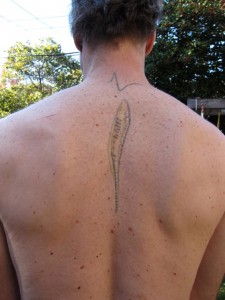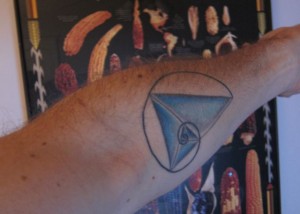After months of emails, instant messages, not-so-instant messages, and dammit-downright-slow messages attempting to get his attention, Genotopia has finally secured an interview with Dick Dorkins, the professional cynic, atheist, and genomics enthusiast. Genotopia readers first met Dorkins when he commented on the discovery of a gene for thalassophilia. Best known for his work with SPITTOON, the Society for the Prevention of Intelligent-design, Theology, or Other Nonsense, Dorkins is also an outspoken advocate for personal genomics, which he champions as the true path to spiritual enlightenment. In this first part of our interview, he tells about “Project Dick,” his effort to sequence his own genome, and the breakthrough technique that has made it possible.
GT: Thanks for taking the time to sit down with us.
DD: Don’t be an ass. I’m just banging out ex cathedra ripostes in between doing things that matter.
GT: What matters?
DD: Well I do, for starters. But I’m not doing myself at the moment, if that’s what you’re implying.
GT: What are you doing then?
DD: If you must know, I’m looking at myself.
GT: In the mirror? Doesn’t that make it confusing to type?
DD: Don’t be an ass. Not my image. My self. My true self. My genome.
GT: Ah, your DNA sequence. But wait—your genome famously refused to be sequenced.
DD: That’s right, it did. But I kicked its nucleic butt and now it’s as docile as a retriever.
GT: How did you do that?
DD: Through a breakthrough technology called “nuclear sequencing.” Not as in the cell nucleus. As in Hiro-fucking-shima. You’ve heard of shotgun sequencing?
GT: Sure. Craig Venter’s technique of “blasting” the entire genome into smithereens of DNA, sequencing the fragments with high-powered automated sequencers, and stitching the pieces together using massive computing power. It’s how the Human Genome Project finished early.
DD: You’re not as dumb as you type. Well, as you know, I’ve formed a company to sequence my own genome. We call it “Project Dick.”
GT: Catchy. I like the ambiguity.
DD: I came up with it myself. Anyway, as you say, my genome was impervious to shotgun sequencing. It squinted down the barrel of Venter’s biggest ABI machine, tossed back its head and gave a bitter, defiant laugh: “Hahahaha.” There might even have been an evil “Bwa” at the beginning. We hit it with everything we had and when the smoke cleared my genome was still just sitting there smirking.
GT: Tough. What did you do?
DD: We invented machine-gun sequencing. But still, nothing. My genome wears kevlar nucleus armor. It drives an Armored Personnel Carrier. Not so surprising really, when you consider the individual it encodes. So this brilliant chap we’re collaborating with out at Stanfoo University, Will B. Rich, upped the ante, so to speak, and invented the atom bomb of DNA sequencing.
GT: How does it work?
DD: It literally destroys my DNA, atom by atom, and then reassembles it. The processing power this requires is staggering.
GT: My God.
DD: Not quite. Google.
GT: You hired Google to sequence your DNA?
DD: Hired? Don’t be an ass. Like God, Google is everywhere. We have written code that borrows computing cycles one at a time from every desktop and mobile device on the planet and uses them to assemble the sequence of my genome. In between the “A” and the question mark of your last question, your Android contributed one tiny piece of my genome. Your device is sequencing me. You are sequencing me.
GT: You’re welcome. So in a sense, Google already has all this information—about you, and, theoretically, anyone else—and you are simply tapping in and extracting it? Should we be concerned about this?
DD: Google knows. Google cares.
GT: Dick! What you’re suggesting is the exploitation for personal gain of a giant omniscient, omnipresent, celestial intelligence, privy to our every move and capable of probing into the deepest recesses of our genetic structure–and that moreover, it is in a sense voluntarily created by our desire for communication with our fellow man and our desire for really cool apps! Explain, please!
DD: Can’t. Later, at my leisure, I will try to explain it to you slowly. But it’s time for my cup of special Punjabi aceyjee tea. It has telomere-lengthening properties, don’t you know. So ciao for now.
(Check back later for Part II of our interview!)


You must be logged in to post a comment.